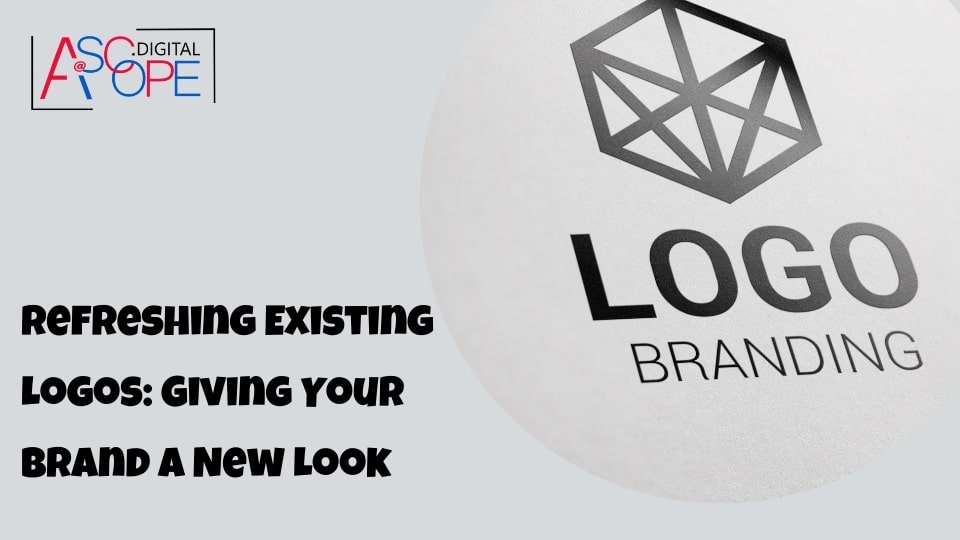In the fast-paced world of business, branding plays a pivotal role in a company’s success. A brand’s identity, often encapsulated in its logo, is a powerful tool that conveys its values, mission, and uniqueness. However, as markets evolve and consumer preferences shift, even the most iconic logos may require a fresh look. This process of rebranding, particularly refreshing an existing logo, can breathe new life into a brand, making it more relevant and appealing to contemporary audiences. In this comprehensive guide, we’ll explore the nuances of rebranding and how refreshing your logo can significantly impact your brand’s perception, ultimately improving traffic and sales for your website. Read more on the other reasons why your website isn’t getting traffic.
The Importance of a Logo in Branding

A logo is more than just a visual symbol; it is the face of a brand. It encapsulates the essence of what a company stands for and distinguishes it from its competitors. A well-designed logo can communicate a brand’s core values, foster brand loyalty, and create a memorable impression in the minds of consumers. As such, any changes to a logo must be approached with careful consideration and strategic planning.
Why Consider Refreshing Your Logo?
Keeping Up with Trends: Design trends evolve, and what was considered cutting-edge a decade ago might now look outdated. Refreshing your logo can align your brand with current design aesthetics, making it more visually appealing and relevant.
Reflecting Company Evolution: As companies grow and evolve, their missions, values, and target audiences may change. A refreshed logo can better reflect these new directions and ensure that the brand’s visual identity aligns with its current state.
Reaching New Audiences: A new logo can attract attention and interest from new demographics or markets that the old logo might not have resonated with. This can open up opportunities for expansion and growth.
Staying Competitive: In highly competitive markets, brands must continuously innovate to stay ahead. A refreshed logo can signal to consumers that a brand is modern, dynamic, and responsive to change.
Revitalizing Brand Perception: If a brand has faced negative publicity or declining sales, a new logo can help in repositioning and revitalizing the brand’s image, signaling a fresh start.
The Process of Refreshing a Logo
Refreshing a logo involves several critical steps that ensure the new design effectively communicates the brand’s message while retaining its identity.
Research and Strategy: Before any design work begins, it’s essential to conduct thorough research. This involves understanding the brand’s history, its current market position, target audience, and competitors. A clear strategy should be formulated, outlining the goals of the rebranding and how the new logo will achieve them.
Maintaining Brand Equity: If a logo has been in use for a significant time, it likely has accumulated brand equity. This is the value derived from consumer recognition and trust. The challenge is to refresh the logo while retaining elements that maintain this equity. Subtle changes can often be more effective than a complete overhaul.
Design Exploration: With a clear strategy in place, designers can begin exploring various design concepts. This phase involves creating multiple iterations, experimenting with different styles, colors, and typography. It’s crucial to involve key stakeholders in this process to gather feedback and ensure alignment with the brand’s vision.
Testing and Refinement: Once a few strong concepts have been developed, it’s important to test them. This can involve focus groups, surveys, or A/B testing to gather insights from the target audience. Based on this feedback, the design can be refined to ensure it resonates well with consumers.
Implementation: After finalizing the design, the new logo must be implemented across all brand touchpoints. This includes the website, social media profiles, packaging, advertising materials, and any other places where the logo appears. A comprehensive rollout plan should be developed to ensure consistency.
Announcement and Promotion: To maximize the impact of the new logo, it’s essential to announce and promote it effectively. This can involve press releases, social media campaigns, and updates to the brand’s website. Communicating the reasons behind the change and what it represents can help in gaining consumer acceptance.
Case Studies of Successful Logo Refreshes
Google: One of the most notable logo refreshes in recent years is Google’s transition from a serif typeface to a modern, sans-serif design. This change reflected the company’s evolution from a simple search engine to a comprehensive technology leader. The new logo was simpler, more versatile, and better suited for mobile devices, which improved its visibility and user experience.
Starbucks: Starbucks’ logo evolution has been a masterclass in brand management. By removing the wordmark and focusing on the iconic mermaid, Starbucks reinforced its global recognition while signaling its growth beyond just coffee. This minimalist approach made the logo more adaptable across various mediums and merchandise.
MasterCard: MasterCard’s logo refresh involved simplifying its iconic overlapping circles and removing the wordmark. This change modernized the logo, making it more versatile for digital use. The simplified design retained the brand’s essence while positioning it as a forward-thinking financial services provider.
Potential Pitfalls in Logo Refreshing

While refreshing a logo can offer numerous benefits, it’s not without risks. Some common pitfalls to avoid include:
Ignoring Brand Equity: Completely overhauling a logo without considering its established recognition can confuse and alienate loyal customers. It’s crucial to retain elements that consumers associate with the brand.
Lack of Clarity: A new logo should communicate the brand’s identity clearly. Overly complex or abstract designs can fail to convey the intended message, leading to a disconnect with the audience.
Not Involving Stakeholders: Rebranding decisions should involve input from various stakeholders, including employees, customers, and partners. Their perspectives can provide valuable insights and help in creating a logo that resonates with all.
Neglecting Consistency: Once a new logo is introduced, maintaining consistency across all platforms and materials is vital. Inconsistent use of the logo can dilute its impact and confuse consumers.
The Impact of a Refreshed Logo on Traffic and Sales
A refreshed logo can significantly impact a brand’s online presence and sales. Here’s how:
Improved Visual Appeal: A modern, visually appealing logo can enhance the overall look of a website, making it more attractive to visitors. This can lead to increased engagement and lower bounce rates.
Increased Trust and Credibility: A well-designed logo can convey professionalism and reliability, building trust with potential customers. This trust can translate into higher conversion rates and sales.
Better Brand Recall: A memorable logo can improve brand recall, making it easier for consumers to remember and recognize the brand. This can lead to repeat visits and increased customer loyalty.
Enhanced User Experience: A logo that’s designed with digital platforms in mind can enhance the user experience. For instance, a simplified logo can load faster and look better on mobile devices, improving overall website performance.
SEO Benefits: While a logo itself doesn’t directly impact SEO, a refreshed brand can attract more traffic, which can positively influence search engine rankings. Additionally, the announcement of a rebrand can generate buzz and backlinks, further boosting SEO.
Practical Steps to Refresh Your Logo
Hire Professional Designers: Engaging experienced designers can ensure that the new logo is of high quality and effectively communicates your brand’s message. Professionals bring expertise in design principles, trends, and branding strategies.
Gather Feedback: Throughout the design process, gather feedback from various sources, including employees, customers, and industry experts. This can provide valuable insights and help in creating a logo that resonates with a wide audience.
Consider the Competition: Analyze competitors’ logos to identify what works and what doesn’t. This can help in creating a unique logo that stands out in the market.
Test Across Platforms: Ensure that the new logo looks good across all platforms and mediums, including websites, social media, print materials, and merchandise. Consistent quality and appearance are crucial for maintaining brand integrity.
Communicate the Change: Clearly communicate the reasons behind the logo refresh to your audience. This can involve blog posts, social media updates, and email newsletters. Transparency helps in gaining acceptance and understanding from consumers.
Conclusion
Refreshing an existing logo is a strategic move that can significantly impact a brand’s identity and market position. By keeping up with design trends, reflecting company evolution, and reaching new audiences, a refreshed logo can breathe new life into a brand. The process requires careful planning, research, and execution to ensure that the new logo resonates with the target audience and maintains brand equity. When done correctly, a logo refresh can improve traffic and sales for your website, enhancing overall brand performance and consumer perception. Read more on the other reasons why your website isn’t getting traffic, and explore how strategic branding decisions can drive business success.


